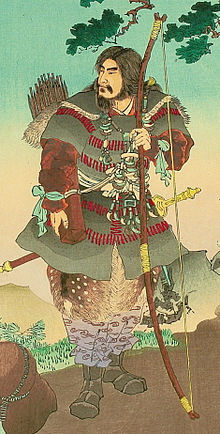You can help expand this article with text translated from the corresponding article in Japanese. (October 2024) Click [show] for important translation instructions.
|
| Emperor Jimmu 神武天皇 | |||||
|---|---|---|---|---|---|
 | |||||
| Emperor of Japan | |||||
| Reign | 660–585 BC (traditional) [2][3] | ||||
| Successor | Suizei | ||||
| Born | Hikohohodemi (彦火々出見) 711 BC or 721 BC eastern Tsukushi-no-shima (now Kyushu) | ||||
| Died | 585 BC (aged 126[4] or 136[5]) possibly Kashihara, Nara | ||||
| Burial | |||||
| Spouses | |||||
| Issue | |||||
| |||||
| Father | Ugayafukiaezu | ||||
| Mother | Tamayori-hime | ||||
| Religion | Shinto | ||||
| Emperor Jimmu | |||||
|---|---|---|---|---|---|
| Japanese name | |||||
| Kanji | 神武天皇 | ||||
| |||||
Emperor Jimmu (神武天皇, Jinmu-tennō) was the legendary first emperor of Japan according to the Nihon Shoki and Kojiki.[2] His ascension is traditionally dated as 660 BC.[6][7] In Japanese mythology, he was a descendant of the sun goddess Amaterasu, through her grandson Ninigi, as well as a descendant of the storm god Susanoo. He launched a military expedition from Hyūga near the Seto Inland Sea, captured Yamato, and established this as his center of power. In modern Japan, Emperor Jimmu's legendary ascension is marked as National Foundation Day on February 11.[8]
There is no evidence to suggest that Jimmu existed and is regarded by most modern scholars as a legendary figure.
Cite error: There are <ref group=lower-alpha> tags or {{efn}} templates on this page, but the references will not show without a {{reflist|group=lower-alpha}} template or {{notelist}} template (see the help page).
- ^ Clements, Jonathan (2017). "Chapter 5". A Brief History of Japan: Samurai, Shogun and Zen: The Extraordinary Story of the Land of the Rising Sun. Tuttle Publishing. ISBN 978-1-4629-1934-5.
- ^ a b Campbell, Allen; Nobel, David S (1993). "Jimmu Emperor". Japan: An Illustrated Encyclopedia. Kodansha. p. 1186. ISBN 406205938X.
- ^ "Genealogy of the Emperors of Japan" (Archive), Imperial Household Agency, 2011.
- ^ Aston 1896, pp. 109–137.
- ^ Chamberlain 1919, p. 188.
- ^ Kelly, Charles F. "Kofun Culture", Japanese Archaeology. April 27, 2009.
- ^ * Kitagawa, Joseph (1987). On Understanding Japanese Religion, p. 145, at Google Books: "emphasis on the undisrupted chronological continuity from myths to legends and from legends to history, it is difficult to determine where one ends and the next begins. At any rate, the first ten legendary emperors are clearly not reliable historical records."
- Boleslaw Szczesniak, "The Sumu-Sanu Myth: Notes and Remarks on the Jimmu Tenno Myth", in Monumenta Nipponica, Vol. 10, No. 1/2 (Winter 1954), pp. 107–26. doi:10.2307/2382794. JSTOR 2382794.
- ^ Trevor, Malcolm (2001). Japan: Restless Competitor: The Pursuit of Economic Nationalism. Psychology Press. p. 79. ISBN 978-1-903350-02-7.